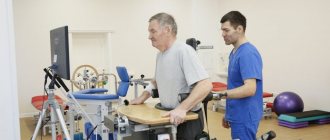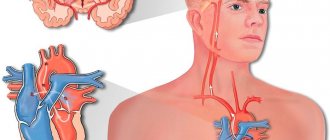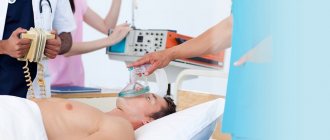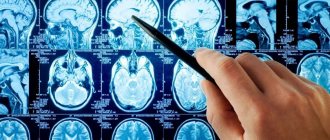"Blow, another blow..."
Every year more than 5 million Russians suffer a stroke. Only 15% of patients who have suffered a cerebral catastrophe return to their normal lifestyle. Unfortunately (and this is a worldwide problem), no drugs have been invented to date, and no effective methods of treating stroke have been developed. If a brain catastrophe has occurred, even the best doctor can only influence the outcome of the disease to a very small extent. The most we can hope for is the ability to save the patient’s life, since the destroyed areas of the brain, alas, cannot be restored. So is it worth waiting for the thunder to strike? Isn't it better to prevent a possible disaster?
Risk factors – condition or cause?
The existing concept of risk factors (there are more than 80 of them!) establishes mathematically reliable connections between diseases (hypertension, atherosclerosis), syndromes, life circumstances and the occurrence of stroke. However, risk factors are only conditions that contribute to stroke, but are not its causes. Is it possible to prevent it by overlooking the causes of a disease? I think the answer to this question is obvious. As for the reasons... Frankly speaking, many doctors still do not delve too deeply into this problem. Obviously, they are waiting for an official form to land on the table with a clear indication of where to hit in order to save humanity from a serious illness. Meanwhile, the cause of stroke, back in the 80s of the now past century, was formulated by the outstanding Russian cardiologist I.K. Shkhvatsabaya. The patient's medical history can be aggravated by many risk factors - atherosclerosis, coronary heart disease, he may live in an environmentally unfavorable or stressful atmosphere, smoke and abuse alcohol... However, until a specific vascular situation arises, which is defined as a hemodynamic crisis, there will be no stroke .
A fatal coincidence...
Hemodynamic crisis is an acute disturbance of systemic or regional hemodynamics, leading to dysfunction or damage to the brain. Hemodynamic crisis develops as a result of decompensation in the heart, rhythm disturbances, sudden changes in vascular tone, increased blood viscosity, intravascular thrombus formation, and activation of atherosclerotic plaques. And more often, a hemodynamic crisis is the result of a combination of circumstances (stress, geomagnetic storms and atmospheric pressure fluctuations, dietary errors, exposure to extreme factors, etc.) that disrupt the balance in the system of regulation of blood supply to the brain. Hemodynamic crises are the causes of acute cerebrovascular accident (ACVA), since they are directly related to the development of stroke. Modern research methods make it possible to identify and clinically identify several types of hemodynamic crises: hypertensive, hypotonic, coronary, arrhythmic, angiodystonic, hemorheological, neuroendocrine and obstructive
.
STROKE PREVENTION
Stroke Prevention
is a set of measures aimed at preventing it by identifying and correcting possible risk factors for its development.
Primary prevention
includes a system of educational, hygienic and social measures that are implemented among the healthy population and people with risk factors and are aimed at preventing the development of the first stroke.
Primary prevention
involves two main directions:
mass (population) strategy
and
high-risk strategy
.
Population strategy
involves the prevention of stroke in large populations, regardless of a history of stroke or other vascular diseases. It is aimed at creating a healthy lifestyle, proper nutrition, and reducing average blood pressure in a large population of organized people. Such a strategy requires the development and funding of national programs for primary stroke prevention and is the subject of activities by educational bodies and general practitioners.
High Risk Strategy
provides for the identification by medical workers of persons with the highest risk of developing vascular diseases and the implementation of appropriate individual treatment and preventive measures for them.
Recommendations for primary prevention of stroke.
- Lifestyle modification.
- Low-calorie, salt-free diet
(recommended amount of salt no more than 2-3 grams). - Weight loss
for overweight and obese individuals to reduce the risk of stroke. - Smoking cessation for smokers and abstinence for non-smokers is recommended
to reduce the risk of stroke. - Correction of arterial hypertension
. Clinical guidelines for stroke prevention indicate that arterial hypertension is an important, well-studied and correctable risk factor for ischemic and especially hemorrhagic stroke, transient ischemic attack and vascular dementia. Regular blood pressure monitoring is necessary for patients with arterial hypertension.
The use of automatic devices is allowed; the patient or his relatives can measure blood pressure independently using automatic blood pressure meters at home. This method, which has become widespread in recent years, is referred to as the method of self-monitoring of blood pressure (SCAD). Microlife A2 Standard provides convenient and accurate blood pressure measurement at home. The threshold signal allows easy classification of measurement values. A2 Standard stores up to 30 measurement values and is equipped with PAD technology for early detection of cardiac arrhythmias. Additionally, the device comes with a wide range of ML cuffs that fit all common shoulder sizes.
- Diabetes.
It is very important to control your blood glucose levels. You can teach the patient to carry out regular monitoring at home using a glucometer. - Atrial fibrillation.
Effective prevention of stroke in patients with atrial fibrillation is a major challenge.
To ensure timely detection of AF in all patients aged >65 years, periodic screening for the presence of AF using BP A6 PLUS is recommended. AFIB (Atrial Fibrillation Detection) diagnostic function for atrial fibrillation - detects atrial fibrillation. Hypertension and atrial fibrillation are the most common risk factors for heart disease and stroke.
- Clinical examination of persons at high risk of developing CVD.
Secondary prevention of stroke
Should be carried out among patients who have suffered TIAs and strokes.
For targeted implementation of preventive measures, it is necessary to take into account the risk factors in each individual patient (presence of hypertension, AF, diabetes, and others), as well as the results of additional examination.
Based on the examination and clarification of the type of violation, an individual program for the prevention of repeated violations is developed. In most cases, measures begin with non-medicinal ones, and if necessary, medicinal ones are added. The role of drug therapy is just as important for primary prevention, but to a greater extent for secondary prevention, i.e. with a history of previous TIAs and strokes.
Preventing the development of situations that provoke a recurrent stroke
In addition to using effective and surgical methods for secondary prevention of strokes, it is necessary to prevent the development of situations that provoke a recurrent stroke. Such as hypoxia and low blood pressure during surgical operations, a sharp decrease in blood pressure during antihypertensive therapy, taking large doses of sedatives that induce deep sleep, anemia, systemic arterial hypotension, etc. Effective treatment is necessary for concomitant somatic diseases, including diabetes.
In addition, regular courses of vascular, neurotrophic, and metabolic therapy improve the well-being of patients and reduce the risk of exacerbations of cerebrovascular insufficiency. It should be remembered that the choice of vasoactive drugs is made taking into account the examination performed, the state of the cardiovascular system, and cerebral vessels. Most nootropic (improves mental activity), neurotrophic (stimulates recovery processes in the brain) drugs are dose-dependent and their best effectiveness is achieved if the recommended doses and timing of treatment are followed.
"Crazy" pressure
Hypertensive crisis is one of the most common causes of ischemic and hemorrhagic stroke. Most strokes are associated with a hypertensive crisis, one way or another. For a doctor, this connection is always obvious, since recording blood pressure (BP) when a clinical picture of the disease occurs is simple and accessible. A hypertensive crisis can lead to disruption of autoregulation of cerebral circulation and rupture of an intracranial artery - hemorrhagic stroke. But more often, high blood pressure is accompanied by spasm of the arteries, increased load on the heart and the development of hemodynamic ischemic stroke. In recent years, researchers have begun to pay attention to relative hypotension (decreased blood pressure) in patients adapted to high blood pressure as a possible cause of stroke. Hypotension is especially dangerous for patients with severe atherosclerotic lesions of the main arteries of the brain - stenoses. A sudden drop in blood pressure in patients with atherosclerotic changes in the arterial system of the brain leads to a critical decrease in cerebral blood flow. Hypotonic crises are typical for patients with parkinsonism; they may be a consequence of inadequate treatment of arterial hypertension.
Therapy for ischemic stroke in the acute period
In the first three weeks (during the acute period), general measures are taken:
- The required oxygen level is maintained;
- Blood pressure stabilizes;
- Cardiac activity is under medical supervision;
- The condition of the bladder and intestines is monitored;
- Passive gymnastics is carried out on all limbs of the victim;
- Prevention of bedsores;
- Antibacterial therapy, including taking antifungal drugs.
Depending on the specifics and subtype of ischemic stroke, special therapy is carried out.
Acute ischemic stroke may recur if the diagnosis is not reliable and not all emergency measures have been taken. In the acute period, secondary hemorrhage into damaged tissue of the cerebral cortex poses a great danger. As a rule, this occurs in the first 10 days after the onset of a stroke. It is almost impossible to detect this complication visually. Only with the help of computed tomography and x-ray examination do they find a new lesion and take action. The reason for this complication is the lack of necessary control over blood pressure, as well as reperfusion therapy. Some patients have serious contraindications for it.
Clinical Brain Institute Rating: 4/5 — 2 votes
Share article on social networks
Look for the reason in the heart
Coronary crisis is a consequence of acute coronary insufficiency. More often it occurs with obvious signs of angina, but sometimes in the form of silent myocardial ischemia. In any case, a coronary crisis can lead to hemodynamic disturbances directly related to brain damage. Arrhythmic crisis (paroxysmal forms of cardiac arrhythmias) is one of the main causes of cardioembolic and hemodynamic stroke. At least 20% of strokes are caused by cardioembolism. The mechanism of brain damage during arrhythmia is associated with a sharp decrease in the pumping function of the heart during the period of arrhythmia, or with the release of thrombotic masses that form in the chambers of the heart into the arteries of the brain.
Stroke: clinic and treatment
Treatment of acute stroke will be more successful if you consult a doctor in a timely manner. If you or a loved one:
- concerns about dizziness, nausea, weakness or numbness in the limbs;
- there were difficulties in swallowing, speech functions were impaired;
- drowsiness, inability to adequately respond to what is happening around;
- inability to maintain a stable position, impaired consciousness.
In this case, a hemorrhagic or ischemic stroke of the brain can be suspected in time, the treatment of which should be carried out only in a hospital setting.
Take care of your spine
Angiodystonic crisis is characteristic of vertebrogenic disorders of vascular tone. Osteochondrosis, arthrosis, post-traumatic changes in the cervical and thoracic spine often lead to irritation of numerous nerve structures and the occurrence of vascular spasm. Vertebrogenic disorders of vascular tone are characterized by the participation of the vertebral arteries. Angiodystonia is an indispensable companion of migraine. Currently, migraine stroke is the result of a severe migraine attack.
The more thorough the examination, the better the results...
The results of a thorough cardioneurological examination in most cases provide sufficient grounds to assume that the patient is developing one or another version of a hemodynamic crisis and to determine the possible cause of the stroke. In other words, the concept of hemodynamic crises allows us to identify a thin link, the “rupture” of which can lead to a stroke. “Deciphering” the possible mechanisms of a stroke that has not yet occurred opens up new opportunities in the preventive therapy of cerebrovascular diseases. The chosen treatment regimen is aimed at eliminating the most likely causes of stroke, it becomes individually adapted and therefore more effective.
The probability of a stroke can be calculated!
There are several ways to assess the likelihood of disease. The most reliable is statistical. It is known that every year 5–7% of “hypertensive patients” and 5% of patients with cardiac arrhythmias suffer a stroke. Severe atherosclerotic lesions of the carotid arteries (stenoses) “bring” another 5–7% per year. After 50, every decade of life doubles your risk of having a stroke. If one of the parents had a stroke, the amount is doubled. Thus, if we take a person over 50 years old with a “burdened” heredity, hypertension and heart problems, then the probability of him getting a stroke is close to 50%!
Treatment
If an ischemic stroke is suspected, urgent hospitalization is performed. Treatment is carried out in a hospital under monitoring of key indicators - respiration, blood pressure, temperature, number of heart beats. To do this, sensors from special equipment are attached to the patient. If necessary, artificial respiration is performed.
During treatment, it is necessary to restore cerebral blood flow and save cells located in the ischemic zone of the “penumbra” and oligemia. It is equally important to prevent a new stroke and brain swelling. For this, the patient is prescribed:
- Neuroprotectors that protect brain structures from destructive aggressive substances formed during a stroke. These medications enhance metabolic processes and improve cell adaptability. The neuroprotective drug group includes glycine, nimedipine, riluzole, mexidol, actovegin, succinic and lipoic acids.
- Vasoactive drugs that dilate blood vessels and reduce the negative effects of oxygen starvation - Cavinton, Trental, Cinnarizine, Sermion, Stugeron.
- Medicines that prevent the “gluing” of red blood cells and platelets - ticlid, clopidogrel, Plavix. These drugs lower cholesterol levels, reducing the risk of another stroke.
- Substances that reduce blood clotting (anticoagulants) - aspirin, heparin, cardiomagnyl. Patients suffering from stomach diseases are treated with an anticoagulant enclosed in a coating that is soluble in the intestines - thrombo-ASS. Patients suffering from atrial fibrillation are prescribed anticoagulants - vitamin K antagonists.
- Medicines to lower blood pressure caused by hypertension and the body's stress response. In hypertensive patients, having an upper (systolic) pressure reading of 180-190 mm. rt. Art., it is reduced by no more than 20%, so as not to provoke stagnation of blood in the vessels and increased ischemia. Captopril, nimodipine, nicardipine and their analogues are suitable for this purpose.
- Drugs that normalize heart function and eliminate symptoms of heart failure - Corinfar, Kurantil.
- Drugs that increase blood pressure - dopamine, gutron, mezaton - are prescribed for hypotensive patients.
- Droppers with piracetam, actovegin, vinpocetine and pentoxifylline are indicated to thin the blood and restore brain function.
- Droppers with dextrans (reopolyglucin, rheomacrodex) are used to reduce blood viscosity, increase blood flow and improve blood microcirculation.
- Diuretics - Lasix, mannitol, furosemide - are prescribed to prevent cerebral edema.
The consequences of a stroke take a long time to eliminate, so after the inpatient period, the patient is treated at home. In the future, many months of rehabilitation are required, aimed at restoring lost functions.
Don't play roulette with life!
People at risk need to be especially vigilant - not to miss the “harbingers” of brain catastrophe, which are often disguised as other, very common diseases. Are you suffering from attacks of headaches, dizziness, vision and speech are periodically and briefly impaired, memory has deteriorated, you feel (even a slight) numbness in your limbs, your heartbeat is unstable? It is dangerous to postpone a visit to the doctor in such situations. If, despite the recommendations you follow, unpleasant symptoms do not go away, do not waste time: take a referral to a specialized medical center where there are qualified specialists and modern medical equipment. On the basis of CELT there is a specialized service “STOP-Stroke”, which has all the necessary technical equipment that allows you to quickly and with a high degree of reliability not only establish the degree of risk of a brain catastrophe, but also effectively prevent it. The examination program is not built according to the traditional scheme (consultations first with one, another, possibly a third specialist, then, as a rule, a consultation...), but is based on the close integration of angioneurology and cardiology. Each anti-stroke “route” begins in the office of a highly qualified specialist – an angioneurologist. You will be asked to fill out a unique questionnaire that allows you to judge the pre-stroke status of each patient, the volume and nature of the package of medical services he needs. Based on a comprehensive examination, each patient receives a detailed treatment plan that will reliably relieve him of one of the most serious diseases of our time - stroke.
First aid for stroke
In the case of a stroke, the most important thing is to get the person to a specialized hospital as quickly as possible, preferably within the first hour after symptoms are noticed. It should be borne in mind that not all hospitals, but only a number of specialized centers are equipped to provide proper modern stroke care. Therefore, attempts to independently transport a patient to the nearest hospital during a stroke are often ineffective, and the first action is to call emergency services for medical transport.
Before the ambulance arrives, it is important not to allow the patient to eat or drink, since the swallowing organs may be paralyzed, and then food entering the respiratory tract can cause suffocation. At the first signs of vomiting, the patient's head is turned to the side so that the vomit does not enter the respiratory tract. It is better to lay the patient down with pillows under his head and shoulders, so that the neck and head form a single line, and this line makes an angle of about 30° to the horizontal. The patient should avoid sudden and intense movements. The patient is unbuttoned from tight, obstructive clothing, his tie is loosened, and his comfort is taken care of.
In case of loss of consciousness with absent or agonal breathing, cardiopulmonary resuscitation is started immediately. Its use greatly increases the patient's chances of survival. Determining the absence of a pulse is no longer a necessary condition for starting resuscitation; loss of consciousness and absence of rhythmic breathing are sufficient. The use of portable defibrillators further increases survivability: when in a public place (cafe, airport, etc.), first aid providers need to ask the staff if they have a defibrillator or nearby.





